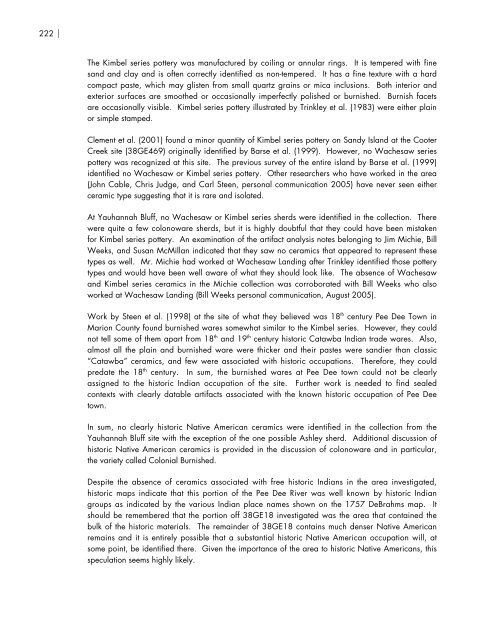Archaeological Investigations at Yourhaney Plantation (38GE18)
Archaeological Investigations at Yourhaney Plantation (38GE18)
Archaeological Investigations at Yourhaney Plantation (38GE18)
Create successful ePaper yourself
Turn your PDF publications into a flip-book with our unique Google optimized e-Paper software.
222The Kimbel series pottery was manufactured by coiling or annular rings. It is tempered with finesand and clay and is often correctly identified as non-tempered. It has a fine texture with a hardcompact paste, which may glisten from small quartz grains or mica inclusions. Both interior andexterior surfaces are smoothed or occasionally imperfectly polished or burnished. Burnish facetsare occasionally visible. Kimbel series pottery illustr<strong>at</strong>ed by Trinkley et al. (1983) were either plainor simple stamped.Clement et al. (2001) found a minor quantity of Kimbel series pottery on Sandy Island <strong>at</strong> the CooterCreek site (38GE469) originally identified by Barse et al. (1999). However, no Wachesaw seriespottery was recognized <strong>at</strong> this site. The previous survey of the entire island by Barse et al. (1999)identified no Wachesaw or Kimbel series pottery. Other researchers who have worked in the area(John Cable, Chris Judge, and Carl Steen, personal communic<strong>at</strong>ion 2005) have never seen eitherceramic type suggesting th<strong>at</strong> it is rare and isol<strong>at</strong>ed.At Yauhannah Bluff, no Wachesaw or Kimbel series sherds were identified in the collection. Therewere quite a few colonoware sherds, but it is highly doubtful th<strong>at</strong> they could have been mistakenfor Kimbel series pottery. An examin<strong>at</strong>ion of the artifact analysis notes belonging to Jim Michie, BillWeeks, and Susan McMillan indic<strong>at</strong>ed th<strong>at</strong> they saw no ceramics th<strong>at</strong> appeared to represent thesetypes as well. Mr. Michie had worked <strong>at</strong> Wachesaw Landing after Trinkley identified those potterytypes and would have been well aware of wh<strong>at</strong> they should look like. The absence of Wachesawand Kimbel series ceramics in the Michie collection was corrobor<strong>at</strong>ed with Bill Weeks who alsoworked <strong>at</strong> Wachesaw Landing (Bill Weeks personal communic<strong>at</strong>ion, August 2005).Work by Steen et al. (1998) <strong>at</strong> the site of wh<strong>at</strong> they believed was 18 th century Pee Dee Town inMarion County found burnished wares somewh<strong>at</strong> similar to the Kimbel series. However, they couldnot tell some of them apart from 18 th and 19 th century historic C<strong>at</strong>awba Indian trade wares. Also,almost all the plain and burnished ware were thicker and their pastes were sandier than classic“C<strong>at</strong>awba” ceramics, and few were associ<strong>at</strong>ed with historic occup<strong>at</strong>ions. Therefore, they couldpred<strong>at</strong>e the 18 th century. In sum, the burnished wares <strong>at</strong> Pee Dee town could not be clearlyassigned to the historic Indian occup<strong>at</strong>ion of the site. Further work is needed to find sealedcontexts with clearly d<strong>at</strong>able artifacts associ<strong>at</strong>ed with the known historic occup<strong>at</strong>ion of Pee Deetown.In sum, no clearly historic N<strong>at</strong>ive American ceramics were identified in the collection from theYauhannah Bluff site with the exception of the one possible Ashley sherd. Additional discussion ofhistoric N<strong>at</strong>ive American ceramics is provided in the discussion of colonoware and in particular,the variety called Colonial Burnished.Despite the absence of ceramics associ<strong>at</strong>ed with free historic Indians in the area investig<strong>at</strong>ed,historic maps indic<strong>at</strong>e th<strong>at</strong> this portion of the Pee Dee River was well known by historic Indiangroups as indic<strong>at</strong>ed by the various Indian place names shown on the 1757 DeBrahms map. Itshould be remembered th<strong>at</strong> the portion off <strong>38GE18</strong> investig<strong>at</strong>ed was the area th<strong>at</strong> contained thebulk of the historic m<strong>at</strong>erials. The remainder of <strong>38GE18</strong> contains much denser N<strong>at</strong>ive Americanremains and it is entirely possible th<strong>at</strong> a substantial historic N<strong>at</strong>ive American occup<strong>at</strong>ion will, <strong>at</strong>some point, be identified there. Given the importance of the area to historic N<strong>at</strong>ive Americans, thisspecul<strong>at</strong>ion seems highly likely.







